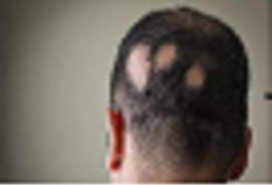Alopeica Areata Treatment
 |
 |
 |
One of the most challenging aspects of alopecia areata is its unpredictability. Hair loss can occur suddenly and may resolve on its own, or it can progress to more extensive baldness. While alopecia areata does not cause physical harm, its psychological impact can be significant, affecting self-esteem and confidence.
Alopecia areata is a complex condition that requires a comprehensive approach to treatment and support. By raising awareness and understanding, we can better support individuals affected by alopecia areata and work towards effective treatments and solutions.
Alopecia Symptoms
One of the primary symptoms of alopecia areata is sudden hair loss in small, round patches on the scalp, eyebrows, or other areas of the body. These patches may vary in size and can appear rapidly, often without any warning. In some cases, individuals may experience tingling or itching in the affected areas before hair loss occurs.Another symptom of alopecia areata is the presence of "exclamation mark" hairs. These are short, broken hairs that are narrower near the scalp and wider at the top, resembling an exclamation mark. Additionally, individuals with alopecia areata may notice changes in the texture or appearance of their nails, such as pitting or ridges.
While alopecia areata typically does not cause physical discomfort, the emotional impact can be significant. Hair loss can affect self-esteem and confidence, leading to feelings of embarrassment or self-consciousness.
It's essential to recognize these symptoms and seek medical attention if you suspect you may have alopecia areata. Early diagnosis and intervention can help manage the condition and minimize hair loss, improving overall well-being and quality of life.
How do dermatologists diagnose alopecia areata?
Your dermatologist will examine the area(s) with hair loss carefully and look at your nails. Your dermatologist will also ask some questions. This may be enough to diagnose you.Because there are so many reasons for hair loss, testing is sometimes necessary to make sure alopecia areata is the cause of your hair loss.
A blood test can look for other diseases caused by the immune system. Sometimes, other tests are necessary.
If you have alopecia areata, your dermatologist will talk with you about how the disease is affecting your life and whether treatment is recommended.
Alopecia Treatment
Children 10 years of age and younger
Treatment options for children 10 years of age and younger are:Corticosteroid you apply to the bald spots: Prescription-strength corticosteroids can help regrow hair. You apply this medication once or twice a day. For children, this alone can be an effective treatment.
Minoxidil: can help maintain the regrowth after you stop applying the corticosteroid. It has few side effects, so it’s considered a good option for children.
For older people, treatment options are based on the amount of hair loss.
Injections of corticosteroids: To help your hair regrow, your dermatologist will inject this medication into the bald areas. These injections are usually given every 4 to 8 weeks as needed.This is considered the most effective treatment for people who have a few patches of hair loss.
Minoxidil: can help you keep the hair growth stimulated by another treatment. You will need to apply it 2 to 3 times a day. It’s helpful for the scalp, beard area, and eyebrows.
Corticosteroids: You apply this medication to the bald spots once or twice a day as instructed by your dermatologist. This medication tends to be less effective in adults than in children for hair regrowth.
Anthralin: You apply this medication to the bald spots, let it sit on the skin for as long as your dermatologist says, and then wash it off. best results, you’ll also use minoxidil.
Don't let Alopecia Areata take away your beautiful hair. Visit Dermasolutions today and get the best Alopecia Areata treatment in Pune.






